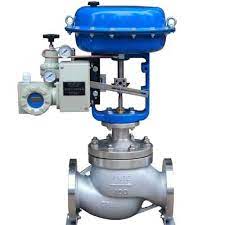A control valve is a control device used to manage and direct the flow of fluids by varying the size of the flow passage. This device provides the direct control of flow, temperature, pressure, or liquid level. Control valves are used in just about every process system used at wellsite, oil batteries, gas plants, refineries, and petrochemical plants.
At Gulf Gate, we stock & supply different type of control valves from reputed manufacturers which you need to complete your project & maintenance on time and on budget. We have the resources and expertise to select control valves in a variety of equipment, including wellsite separators and dehydration units, petrochemical plants, gas plants as well as refineries. Various types of flow characteristics are also available. Fast opening, Linear, and Equal percentage flow.
How Does a Control Valve Affect the Control Loop?
Process plants consist of many control loops, networked together to produce a product. The control loops are devised to keep essential process variables such as fluid level, pressure, and temperature within the specified limit. This helps to ensure that the quality of the end product is as desired. Each of these loops creates internal disturbances that may affect the process variables.
Sensors and transmitters are used to collect information about the process variable. A control valve is an end device used to control the process based on this data. This helps to decide the course of action to get the process variable back to where it should be (set point).
What are the Working Principles of a Control Valve?
Pneumatic Actuated
Pneumatic Actuators use an air or gas signal from an external source to produce a modulating control action. The actuator receives the force of the pneumatic signal through a top port. Then, it distributes the signal across the actuator’s diaphragm. As a result, the diaphragm exerts pressure on the diaphragm plate. This moves the valve stem downward in a way that strokes the control valve.
Electric Actuated
They are motor-driven devices. They use an electrical signal that can help create a motor shaft rotation. This movement is converted into a linear motion, which helps to drive the stem in the valve for flow modulation.
Hydraulic Actuated
Hydraulic actuators are similar in operation to pneumatic actuators except they use a fluid, hydraulic oil, as the signal fluid to control the action of the valve. They are used, in place of pneumatic or electric actuated valves when the force required to move the valve stem is high.
We are proud to offer a stimulating and challenging working environment. Competition is keen in our line of business, so it is important that we continuously optimize our services and high-quality solutions that match our customers’ needs.












Gulf Industrial Trading | Bousher , Muscat
info@ggt-int.com
Oman@ggt-int.com
+37282198204
Sun – Thu: 8:30 AM – 05:00 PM
Valve
Fittings
Lash and Lift
Cable
Grounding
Filter and Hoses
Gulf Industrial Trading LLC is certified company, one of the most conspicuous, reliable and leading suppliers for the oil and gas industry in Oman. We stock and supply complete piping products such as Valves, Pipes, Fittings, Fasteners and Gaskets from high quality internationally recognized manufacturers.

©2023 All rights reserved